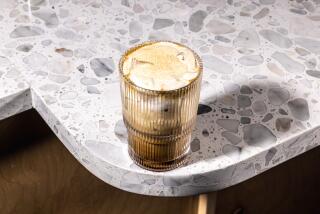A Surge of Technology Brings Home the Popular Espresso Makers
- Share via
There is this surge of hot water that’s forced through a fine grind of dark roast coffee; it is so strong that it presses out all the rich aroma and flavor from the coffee. Pump driven, out comes espresso--an intense black brew underneath a floating strata of golden crema, a creamy tan-colored foam that results when roasted coffee oils are aerated in this heating process.
The brewing cycle is quick. The extraction, severe but pleasant. This is what pump espresso-making is all about. Push a button and there it goes.
No Over-Boiling or Steaming
Although reaching an ideal high temperature, the water from the pump mechanism doesn’t over-boil or steam up to ruin the original taste of the coffee, turning it into a bitter drink. That’s the difference between a pump espresso machine and an old-fashioned steam version.
The modern pump machines come with an extra bonus favored by Americans and borrowed from the Capuchin monks: cappuccino. If you have always thought that this beverage is espresso topped with whipped cream, don’t worry, you’re not alone. In a national “espresso I.Q.” survey conducted recently by Krups, about half of the people defined cappuccino as such. All it is is espresso with steamed milk and froth.
So who’s making rich espresso possible for the home these days?
Leader in Technology
There’s Gaggia. They’re way ahead with the technology since Achille Gaggia patented in 1949 the initial technology that we know as the pump system today. From then on, the Italian company has marketed several models. Still pumping strong in the American market are the high end electronic Baby Gaggia ($500) and the Coffee Gaggia Espresso/Cappuccino ($400).
Introduced about five years ago, the latter is a sturdy unit with a 50-cup capacity and continuous espresso operation. Available in white with black trim, its 100-watt pump power produces excellent crema in espresso while its steam output (less than 1500 water boiler power) lasts about 30 minutes. The milk froth is beautifully thick.
The big news from Gaggia is the forthcoming Gran Gaggia Pump Espresso/Cappuccino Machine. At a low price of $149 for the machine, the company claims it has the quality and performance of a pump machine but the economy of a steam machine. The 750-watt machine will be equipped with two thermostats, one for coffee and one for steam, a 20-cup refillable water tank and a turbo “frother.”
Espresso machines don’t all come from Italy, the land of espresso. There are three easy to operate units that are made in Switzerland with very similar features and accessories: Krups, Rotel Prestige and St. Gallen.
The most exciting feature from Krups L’Espresso Plus thermal block machine ($375, currently introduced at $299) is the option to use Illycaffe espresso pods ($9.95 for 18 espresso pods), which up until now have only been available to restaurateurs. Although the machine makes excellent espresso with the regular blends, the use of the pods can easily spoil you.
They not only taste good, (try the decaffeinated in particular) but these famous pods take the guesswork out of measuring and tamping espresso grounds, avoiding all the messy spills in preparation. Premeasured espresso grounds a from high quality Arabica blend are packed in neat filter packs and all you do is insert them onto the filter basket.
Another plus for the new all-black Krups (which looks the same as the Krups Novo) machine is the thicker foam it produces with its steamer. Blame it on a tiny periscope, a patented detachable cappuccino device that sucks air in as steam is going through the milk to help create greater froth.
The next two machines make wonderful espresso but not as thick a milk foam for cappuccino.
It takes 35 seconds to raise the temperature of fresh cold water to just below boiling with the electronic Rotel Prestige ($299) Espressomat. This is a thermal block machine with a lift-out 54-ounce (for 25 cups) water reservoir. And for a continuous brewing operation, the reheat cycle lasts 15 seconds. Also, for those who prefer tea or other hot beverages, the steam outlet converts to a hot water jet. Sleek looking in white, the Rotel offers hidden compartments to store accessories and the electric cord. The top of the machine also serves as a cup warmer.
The St. Gallen Espresso Machine ($250) is designed to serve two to four two-ounce cups directly into a carafe or espresso cups, and comes with both a two and four-cup espresso basket. Like the Rotel Prestige, it has a convenient warming tray in the top of the unit. One of its prime features is the gauge that indicates when the proper brewing pressure has been reached. It also tells if the pressure in the system is either too little or too much due to improper grind or improper packing of the brewing basket. The unit is available in matte black or white with matte black accents.
Following are some tips to help you make a good cup of espresso and cappuccino.
Use top quality fresh Arabica roast for best-tasting espresso with nice crema . (Robusta beans produce coffee with higher caffeine content than Arabica.) Overly roasted beans result in bitterness. To preserve rich flavors, store beans in an airtight container up to four weeks only; do not refrigerate.
Whole coffee beans are recommended for extra freshness. They should be ground just before use. A burr-type grinder is preferred over a blade type for uniformity of the grind.
The beans should be finely ground but not powdery like flour. They should feel gritty, like salt. Avoid getting too coarse a grind, or water will flow too fast and you will lose coffee body. On the other hand, if the water flows too slowly or not at all, the grind was too fine or packed too firmly in the filter basket.
Although similar in operation, every machine is different so manual instructions should be followed carefully.
Avoid getting a cold espresso by preheating the machine as well as the cups. When preparing cappuccino, start steaming milk before making espresso so that espresso is hot and fresh.
Start with very cold milk; warm milk will not froth as well. For a dense foam, use skim milk. Whole milk, although richer tasting, produces a lighter, less stable, foam.
To get a good froth, take the pitcher of milk (do not fill more than half-full) and insert under the steam nozzle, directing the nozzle almost to the bottom of the pitcher. After about 10 seconds, move the pitcher up and down to continue heating, ending just below the surface of the milk until enough froth is obtained.
The recommended proportion for a serving of cappuccino is one-third espresso and two-thirds hot milk and froth. For pure espresso, 1 1/2 to two ounces; pumping longer causes mild and diluted espresso.
The Coffee Gaggia is available at the Coffee Junction (Tarzana), the Brewery (Santa Monica) and Cook’s Corner (Glendale). The Gran Gaggia will be available at a later date at Bullock’s.
Krups L’Espresso is available at Bullock’s, Robinson’s, Broadway and Williams-Sonoma. For information on availability of the St. Gellan machine, call (914)-241-6700 or write to P.O. Box 118, Mt. Kisco, N.Y. 10549-0118.
The Rotel Espressomat is available at the Brewery (Santa Monica), Coffee, Etc. (Sherman Oaks) and Coffee Importers (Dana Point).
More to Read
Eat your way across L.A.
Get our weekly Tasting Notes newsletter for reviews, news and more.
You may occasionally receive promotional content from the Los Angeles Times.







